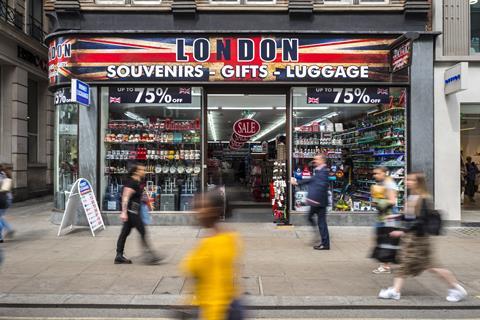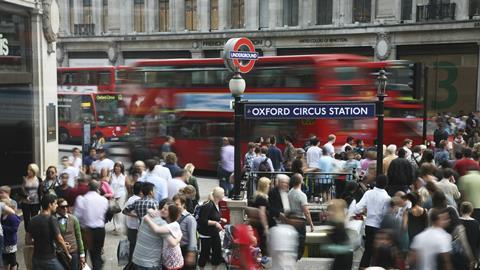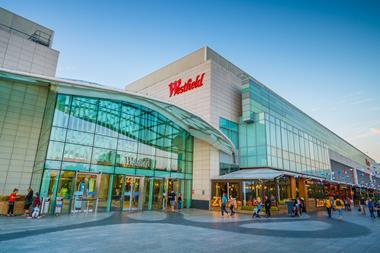It has been a difficult few months for London’s premier shopping destination, Oxford Street.
Last week, huge swathes of the street were closed to traffic as environmental protestors occupied both Oxford Circus and the Marble Arch end. It was also reported that the long-awaited opening of Crossrail could be delayed for another year, to 2021.
Add to this the fact that 19 souvenir gift shops now occupy once-prime retail space on the street and the well-documented problems facing long-time tenants including Arcadia, Monsoon, Accessorize and Debenhams, and the omens do not look good.
So is Oxford Street’s crown as one of the world’s top shopping destinations starting to slip?
The statistics do not make for comfortable reading. Only three letting deals took place last year against a yearly average of around 10. That figure is “drying up further”, according to a top retail adviser, who advises both landlords and retailers on Oxford Street.
“I can only see it continuing to be slow going for the next 18 months at least,” he admits. “There are some serious issues – 19 stores let to gift shops on temporary short-term leases tells its own story. That is a significant chunk of the street.”

His firm has been trying to let space on Oxford Street but “just can’t shift it”, he says, adding that the problem has been exacerbated by Brexit. “There wasn’t one particular factor that got us into this mess, but Brexit has certainly been the cream on top of the mess,” he says.
The adviser is working with a number of international and domestic retailers that are looking at Oxford Street but are not yet willing to commit. “Most are waiting for Brexit, especially if it is a huge commitment,” he says. “Just as you can make a lot of money on Oxford Street, you can lose it just as fast. You have to get it right and [as] we are in a time of uncertainty, people are putting off these decisions.”
A perfect illustration of the street’s struggles is what has happened to the HMV store. It has been four months since the store was vacated after the music retailer went into administration, but it still lays empty. It had been rumoured that yet another gift shop would take the ground-floor space on a temporary lease, but the deal is thought to have fallen through.
Can Oxford Street take any more souvenir shops or candy stores?
Retail agent
The street is also bracing itself for a slew of company voluntary arrangements (CVAs). Arcadia has a big presence on the street, and while you couldn’t see it closing its flagship Topshop store on Oxford Circus, other brands could conceivably go. Add into the mix Debenhams, whose future still remains up in the air, and a large amount of space could soon come to market.
“There just isn’t the demand there to soak it up,” says another retail agent. “Can Oxford Street take any more souvenir shops or American candy stores?”
The delayed opening of Crossrail has hit Oxford Street hard, he says. It was supposed to be launched at the end of last year, but just weeks before its scheduled opening Transport for London announced that the Elizabeth line would be delayed until autumn 2019.
Crossrail delays
It is now thought that the line may not be up and running until summer 2021 due to delays in train and signalling testing. Oxford Street has two Crossrail stations, at Tottenham Court Road to the east and Bond Street to the west. The Bond Street station is also thought to be the furthest behind of all Crossrail stations in terms of building works.

The delay has had a “monumental” impact on the desirability of Oxford Street, the retail agent says. “It has been a building site, especially on the east side, for a long time. That has had an impact on footfall and desirability,” he explains.
“East of Oxford Circus has stalled because of Crossrail; there is a huge gap in the retail offer at Tottenham Court Road; and Bond Street is a bit of an eyesore, too. It has definitely had an impact.”
While there is not sufficient demand to fill all the space coming on to the market, rents have yet to fall significantly. Zone-A rents had been pushing £1,000/sq ft a year ago and have only fallen marginally to £950/sq ft.
This is partly due to the lettings to souvenir shops, which are willing to pay high rents on a short-term basis. Another factor is that landlords are not willing to budge on rents, having bought the Oxford Street properties on sub-3% yields in some cases.
Stifling deals
This unwillingness to reduce rents is stifling deals. “We are working with occupiers who are looking at London but do not want to pay the rents on Oxford Street,” the senior adviser says.
“If we were marketing on Oxford Street, we would have to quote sub-£900/sq ft to get the right level of interest, but landlords aren’t willing to go that low.”
Other factors have had a big impact, including business rate rises of 40% for most stores and brands consolidating their Oxford Street presence into one big store.
Right now, we need to weather the storm, but the future is bright
Richard Scott, Nash Bond
Richard Scott, director at retail agency Nash Bond, says Oxford Street suffers from a lack of “fit-for-purpose” properties that offer the double-height units most retailers desire for their flagship stores.
“There are a number of sites that don’t deliver that and they struggle to find new tenants. There is a requirement of the local planning authority and stakeholders to be positive in allowing building alterations to match requirements of retailers.”
However, there are some positive messages coming from the street. Japanese fashion brand Uniqlo recently acquired its store for a rumoured £270m at a net initial yield of sub-2%.
“That’s a real commitment to the street,” says Scott. “That’s a great statement by one of the most active global retailers.”

Scott believes that significant retail developments currently underway, including Derwent London’s Soho Place and the Outernet, will be welcomed by retailers and create a positive buzz around Oxford Street again.
“When Crossrail opens and the building works finish, footfall will come up again,” he predicts. “In five years’ time, Oxford Street will be completely different. Right now, we need to weather the storm, but the future is certainly bright.
The street remains the premium location for high street retailers and global brands, he maintains: “Oxford Street doesn’t have any competition for that. If it was going to lose its crown, who would it lose it to? It offers retailers a unique proposition.”
Some would beg to differ when it comes to the international arena. There is also growing competition closer to home. Oxford Street’s recent travails contrast sharply with the renaissance of Regent Street, which may not have the department store occupiers its neighbour has but has attracted a diverse range of leading national and international retailers over the past few years.
The key difference between Oxford Street and Regent Street is that the latter is solely owned and managed by the Regent Street Partnership – a joint venture between The Crown Estate and Norges Bank Investment Management – whereas the former has a diverse ownership mix, making asset management more difficult.
Whether this proves to be Oxford Street’s undoing remains to be seen. But for now it remains one of the world’s top shopping destinations – the hope is that Crossrail and other new developments will put an end once and for all to the Oxford Street blues.






























No comments yet